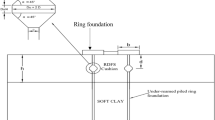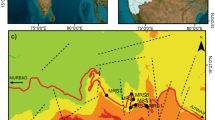Abstract
Weathering can cause adverse effects on the physico-mechanical properties of rocks. Although the processes and outcomes of weathering have been investigated for many rock types, the travertine weathering was not paid enough attention as much as the others. However, the unfavorable effects of weathering may arise rapidly due to travertine’s calcium carbonate composition and highly porous texture. Travertine is an important rock type in building stone market and is generally preferred as an exterior façade material. This rock type was also used in many historical buildings and sculptures in the past, and the signs of extensive weathering can be recognized on some of these travertine-made structures. In this study, it was aimed to characterize the effect of weathering on travertine’s structural properties. The yellow travertine from Eskipazar (Karabuk, Turkey) was selected as the study material and the samples with different weathering degrees were collected from site. The chemical, physical and mechanical properties of those samples were determined in laboratory. The physico-mechanical variations with progressive weathering grades were statistically evaluated and a weathering classification based on a rating system was proposed for yellow travertine in rock material scale. The newly developed system may assist in characterizing the degree of weathering for historical structures built by yellow travertine. Additionally, the classification may also guide to further researches on the weathering of different types of travertine.












Similar content being viewed by others
References
Akin M (2008) Investigation of deterioration of Eskipazar (Karabuk) travertines. Ph.D. thesis. Graduate School of Natural and Applied Sciences, Ankara University, Ankara, Turkey (in Turkish, unpublished)
ANON (1995) The description and classification of weathered rocks for engineering purposes. Working Party Report. Q J Eng Geol 28:207–242. doi:10.1144/GSL.QJEGH.1995.028.P3.02
Arıkan F, Ulusay R, Aydın N (2007) Characterization of weathered acidic volcanic rocks and a weathering classification based on a rating system. Bull Eng Geol Environ 66:415–430. doi:10.1007/s10064-007-0087-0
Bell FG (1996) Engineering properties of soils and rock, 4th edn. Blackwell, Oxford
Bieniawski ZT (1989) Engineering rock mass classifications. Wiley, New York, pp 1–215
Biryol C (2004) Neotectonics and evolution of the Eskipazar basin, Karabük-Turkey. M.Sc. thesis. Graduate School of Natural and Applied Sciences, Middle East Technical University, Ankara, Turkey (unpublished)
Chandler RJ (1969) The effect of weathering on the shear strength properties of the Keuper Marl. Geotechnique 19:321–334
Chave KE, Schmalz RF (1966) Carbonate–seawater reactions. Geochim Cosmochim Acta 30:1037–1048. doi:10.1016/0016-7037(66)90115-3
Child D (1970) The essentials of factor analysis. Holt, Reinhart and Winston Ltd, London, pp 1–107
Dearman WR (1974) Weathering classification in the characterisation of rock for engineering purposes in British practice. Bull Int Ass Eng Geol 9:33–42. doi:10.1007/BF02635301
Dürrast H, Siegesmund S, Prasad M (1999) Die Schadensanalyse von naturwerksteinen mittels ultraschalldiagnostik: möglichkeiten und grenzen. Z Dt Geol Ges 150–2:359–374
Fitzner B, Heinrichs K (1990) Verwitterungszustand und materialeigenschaften der Kalkstein des Naumburger Doms. In: Jb aus dem Forschungsprogramm Steinzerfall-Steinkonservierung, Berlin, vol 2, pp 23–38
Fookes PG, Dearman WR, Franklin JA (1972) Some engineering aspects of weathering with field examples from Dartmoor and elsewhere. Q J Eng Geol 3:1–24
Hajna NZ (2003) Chemical weathering of limestones and dolomites in a cave environment. Speleogenesis Evol Karst Aquifers 1–3:2–6
Irfan TY, Dearman WR (1978) The engineering petrography of a weathered granite in Cornwall, England. Q J Eng Geol 11:233–244. doi:10.1144/GSL.QJEG.1978.011.03.03
ISRM (1978) Suggested method for the quantitative description of discontinuities in rock mass, Geo 10, Standard of Lab and field test. Int J Rock Mech Min Sci Geomed 15:319–368. doi:10.1016/0148-9062(78)91472-9
ISRM (1981) Rock characterization, testing and monitoring: International Society of Rock Mechanics suggested methods. Pergamon Press, Oxford, pp 1–211
Kılıç R (1995) Geomechanical properties of the ophiolites (Çankırı/Turkey) and alteration degree of diabase. Bull Int Assoc Eng Geol 51:63–69. doi:10.1007/BF02594924
Kılıç R (1999) A unified alteration index (UAI) for mafic rocks. Environ Eng Geosci 4:475–483
Köhler W (1991) Untersuchungen zu verwitterungsvorgangen an Carrara-marmor in Potsdam-Sanssouci. In: Möller H–H (ed) Steinschaden - Steinkonservierung. Kolloq. im rahmen des kulturabkommens zw. der BRD und der DDR, Dresden. Berichte zu Forschung und Praxis in der Denkmalpflege in Deutschland, 2, Hannover, pp 50–54
Lawley DN, Maxwell AE (1971) Factor analysis as a statistical method, 2nd edn. Butterworth and Co Ltd, London, pp 1–153
Mosch S, Siegesmund S (2007) Statistisches Verhalten petrophysikalischer und technischer Eigenschaften von Naturwerksteinen. Z Dt Ges Geowiss 158–4:821–868
Moye DG (1955) Engineering geology for snowy mountain scheme. J Inst Eng 27:287–298
Nesbitt HW, Young GM (1982) Early Proterozoic climates and plate motions inferred from major element chemistry. Nature 299:715–717. doi:10.1038/299715a0
Ollier C (1984) Weathering. In: Clayton KM (ed) Geomorphology texts. Longman, London, pp 1–270
Parker A (1970) An index of weathering for silicate rocks. Geol Mag 501–504. doi:10.1017/S0016756800058581
Pentecost A (2005) Travertine. Springer, Berlin, pp 1–445
Price DG (1995) Weathering and weathering process. Q J Eng Geol 28:243–252. doi:10.1144/GSL.QJEGH.1995.028.P3.03
Reiche P (1950) A survey of weathering processes and products. Geology, vol 3. New Mexico Uni Publications,
Robertson EC (1982) Physical properties of building stone. In: Conservation of historic stone buildings and monuments. National Research Council, National Academy Press, Washington, DC, pp 62–86
Ruxton BP (1968) Measures of the degree of chemical weathering of rocks. J Geol 76:518–527
Ruxton BP, Berry L (1957) Weathering of granite and associated erosional features in Hong Kong. Bull Geol Soc Am 68:1263–1292. doi:10.1130/0016-7606(1957)68[1263:WOGAAE]2.0.CO;2
Sadisun IA, Shimada H, Matsui K (2000) Characterization of weathered claystone and their engineering significance. In: Indonesian scientific meeting, Fukuoka, Japan. ISSN:1343-2451
Şaroğlu F, Herece E, Sarıaslan M, Emre Ö (1995) Geology of Yeniçağa-Gerede-Eskipazar region and general characteristics of North Anatolian Fault Zone. MTA Report No: 9873 (unpublished)
Schneider C, Ziesch J, Bauer J, Török A, Siegesmund S (2008) Bauwerkskartierung zur Analyse des Verwitterungszustands an den Außenmauern des Schlosses von Buda (Budapest, Ungarn). Schriftenreihe Dt Geol Ges (SDGG) 59:219–235
Sidraba I (2006) Weatherability of Roman travertine. Ph.D. thesis. Faculty of Material Science and Applied Chemistry, Institute of Silicate Materials, Riga Technical University, Latvia (unpublished)
Sidraba I, Normandin KC, Cultrone G, Scheffler MJ (2004) Climatological and regional weathering of Roman travertine. In: Prikryl R, Siegel P (eds) Architectural and sculptural stone in cultural landscape. Carolinum Press, Prague, pp 211–228
Singh RN, Gahrooee DR (1989) Application of rock mass weakening coefficient for stability assessment of slopes in heavily jointed rock masses. Int J Surf Min 3:207–219
Topal T (1995) Formation and deterioration of fairy chimneys of the Kavak tuff in Ürgüp - Göreme area, (Nevşehir-Turkey). Ph.D. thesis. Middle East Technical University, Ankara, Turkey (unpublished)
Topal T (2002) Quantification of weathering depths in slightly weathered tuffs. Env Geol 42:632–641. doi:10.1007/s00254-002-0566-3
Török A (2006) Hungarian travertine: weathering forms and durability. In: Fort R, Alvarez de Buego M, Gomez-Heras M, Vazquez-Calvo C (eds) Heritage weathering and conservation, vol 1. Taylor & Francis, London, pp 199–204
Török A (2008) Black crusts on travertine: factors controlling development and stability. Env Geol 56:583–584. doi:10.1007/s00254-008-1297-x
TS699 (1987) Natural building stones, investigation and test methods. Turkish Standards Institute, Ankara, pp 1–82
Tuğrul A (1995) Weathering effects on engineering properties of basalts in Niksar Area. PhD thesis. Graduate School of Natural and Applied Sciences, Istanbul University, Istanbul, Turkey (in Turkish, unpublished)
Tuğrul A, Gürpınar O (1997) A proposed weathering classification for basalts and their engineering properties. Bull Int Assoc Eng Geol 55:61–71. doi:10.1007/BF02635416
Vogel DE (1973) Precambrian weathering in acid meta-volcanic rocks from the Superior Province, Villebond Township, South Central Quebec. Can J Earth Sci 12:2080–2085
Weiss T, Rasolofosaon PNJ, Siegesmund S (2002) Ultrasonic wave velocities as a diagnostic tool for the quality assessment of marble. In: Siegesmund S, Weiss T, Vollbrecht A (eds) Natural stone, weathering phenomena, conservation strategies and case studies, vol 205. Geological Society, London, pp 149–164
Acknowledgments
The author would like to thank to the anonymous reviewer of this paper for helpful and valuable comments. This research was financially supported by Ankara University Scientific Research Project (Project No. 2006-0745044).
Author information
Authors and Affiliations
Corresponding author
Rights and permissions
About this article
Cite this article
Akin, M. A quantitative weathering classification system for yellow travertines. Environ Earth Sci 61, 47–61 (2010). https://doi.org/10.1007/s12665-009-0319-7
Received:
Accepted:
Published:
Issue Date:
DOI: https://doi.org/10.1007/s12665-009-0319-7




